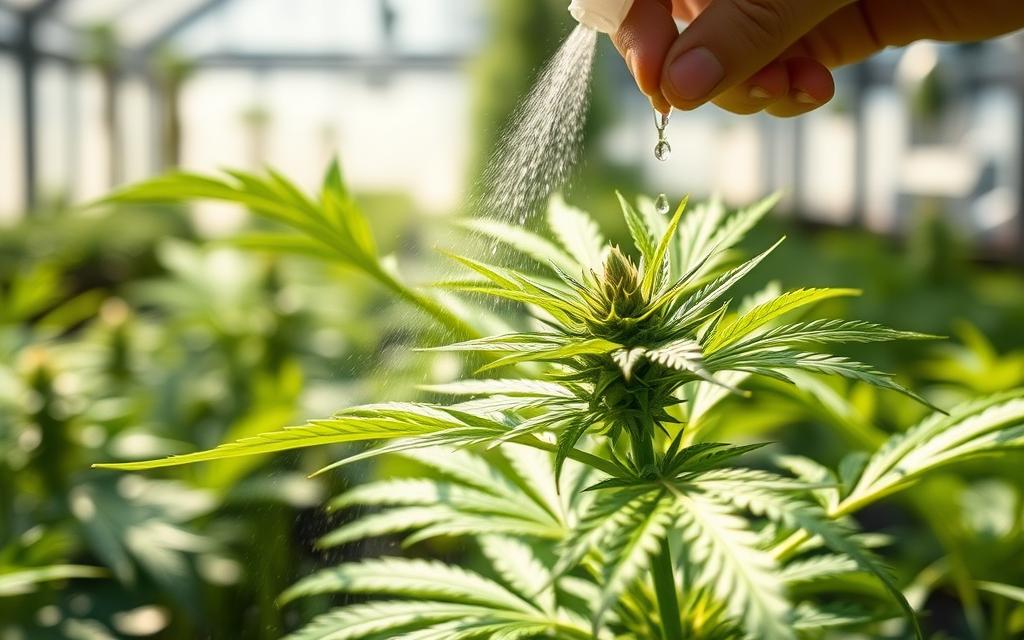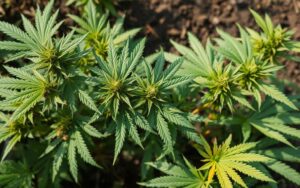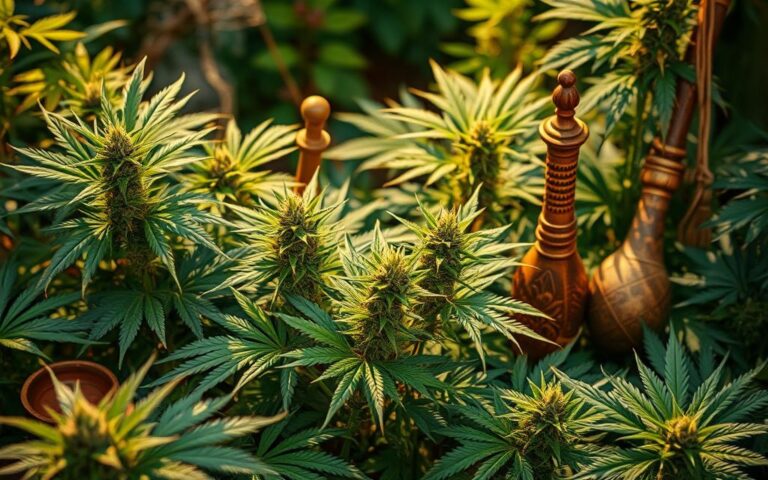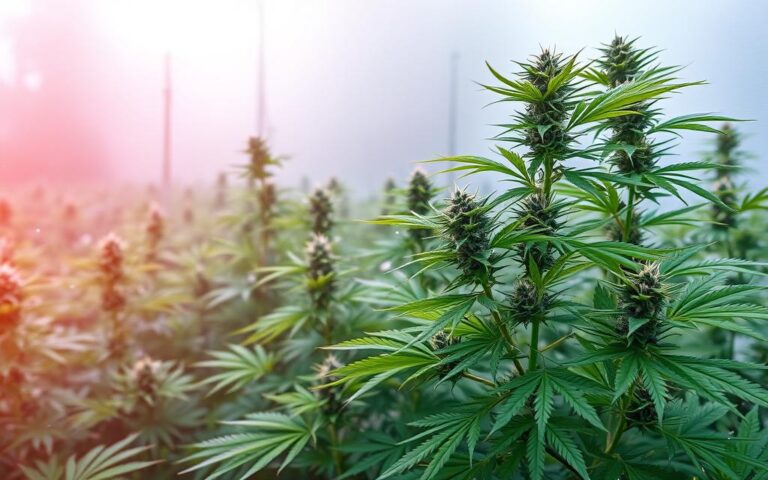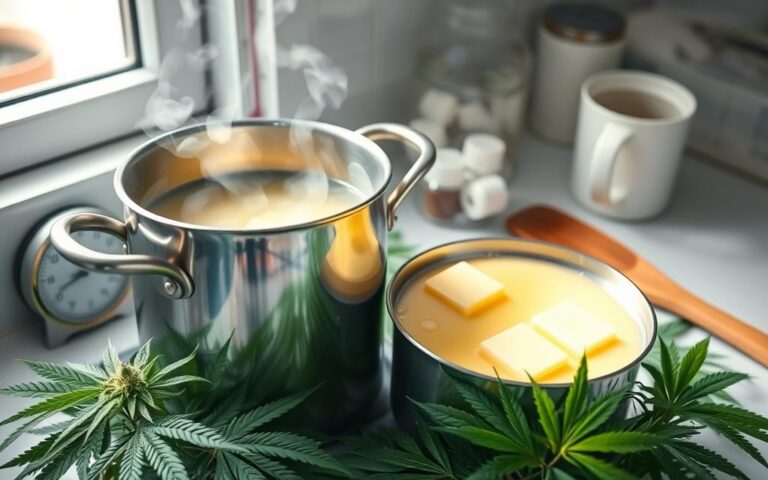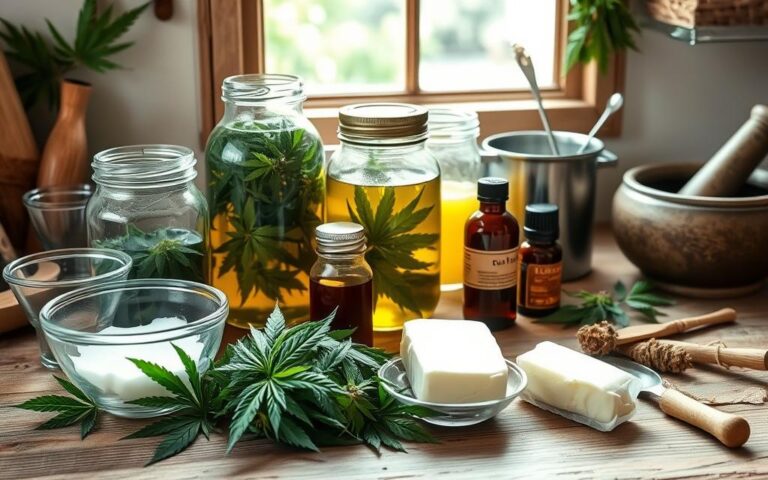Effective Ways to Remove Mold from Cannabis Plants
For cannabis cultivators, dealing with mold isn’t just a hit to profits; it’s also tough emotionally. Learning how to remove mold from cannabis is key to saving your prized plants. Issues like Powdery Mildew and Botrytis can attack your cannabis, harming its health and yield. That’s why knowing the best mold removal methods is crucial.
Powdery Mildew appears as a white, dusty layer on the leaves. It loves the warm, dry conditions found in greenhouses and grow rooms. This harmful fungus can really hurt the health of your plants. It also lowers the quality and strength of your cannabis. To fight it, good airflow and humidity control are essential to prevent cannabis mold.
We’ll explore the different molds that can affect cannabis, how to treat them, and how to stop them from coming back. This knowledge will help you protect your plants and enjoy a great harvest. For more tips, check out this useful article. It offers advice on keeping your cannabis plants healthy.
Understanding the Types of Mold Affecting Cannabis
Cannabis plants can get sick from different molds. These can harm their growth and the quality of the weed. Powdery mildew and botrytis are two main ones to watch out for. It’s important for growers to know about these molds. This helps keep the plants healthy and the cannabis safe to use.
Identifying Powdery Mildew
Powdery mildew looks like a white dust on the leaves. It can stop the plant from making food properly. This leads to weak growth and low-quality buds. Spotting symptoms early, like white or grey spots, is key. This mold spreads fast if not checked. Managing humidity and airflow can help stop it.
Recognising Botrytis or Bud Rot
Botrytis, or bud rot, often starts at the stem’s base, leading to wilting leaves. It’s tricky to spot at first. But looking closely helps when buds start to wilt and turn brown. Knowing how botrytis affects cannabis is critical. It can greatly reduce the quality of your harvest. Keeping an eye on humidity and temperature is vital in controlling it.
Early action against these mold types protects your harvest’s quality and safety. For more tips on keeping your cannabis plants safe, check out how to prevent mold growth.
How to Get Rid of Mold on Cannabis Plants
Dealing with mold on cannabis plants needs fast action and good solutions. Fast action and natural remedies protect your crop from big damage. Knowing what to do and acting quickly is key to keeping plants healthy or facing big losses.
Immediate Actions for Affected Plants
If you find mold on your cannabis plants, act fast. Here are the first steps to take:
- Look closely at plants for mold signs, particularly in buds and lower leaves.
- Remove all leaves and buds that are affected to stop the mold spreading.
- Clean the healthy buds with cold water to remove any spores still there.
- Make sure air flows well around the plants by placing them far apart.
- Keep an eye on humidity, ensuring it stays below 63 percent.
Natural Remedies for Mold Removal
After doing immediate steps, use safe, natural remedies to get rid of the mold. Here are some effective ones:
- Cider Vinegar Spray: Mix cider vinegar and water in a 1:3 ratio and spray on the mold.
- Diluted Milk Solution: Mix milk with water in a 1:2 ratio and spray it on the plants. This fights many molds.
- Potassium Bicarbonate Solution: Mix one teaspoon potassium bicarbonate in one quart of water and use it on infected spots.
- Baking Soda Spray: Combine one tablespoon of baking soda with a litre of water, to combat powdery mildew.
| Remedy | Mix Ratio | Application Method | Effectiveness |
|---|---|---|---|
| Cider Vinegar | 1:3 with water | Spray directly on affected areas | Effective against various molds |
| Diluted Milk | 1:2 with water | Mist on plants | Helps reduce mold presence |
| Potassium Bicarbonate | 1 tsp per quart of water | Apply to infected areas | Targets fungal growth |
| Baking Soda | 1 tbsp per litre of water | Spray on plants | Effective against powdery mildew |
Using these natural remedies helps keep your cannabis plants healthy. They also support environmentally friendly farming. By using these methods, you are taking big steps to fight cannabis mold well.
Preventative Measures Against Mold Growth
Preventing cannabis mold is key to growing healthy plants and getting a good yield. It’s important to focus on airflow, control humidity, and keep the climate steady. These steps greatly lower the risk of mold problems.
Importance of Proper Airflow
Good airflow stops mold before it starts. In indoor places, still air lets mold spores settle down. Moving air helps dry plant surfaces, stopping powdery mildew and other molds from growing. Use fans well to keep air moving and avoid still spots in the room.
Monitoring Humidity Levels
Keeping an eye on humidity is vital for growing cannabis well. Different growth stages need specific humidity. For example, during the leafy stage, 63% to 68% humidity is ideal. When flowers form, lower it to 52% to 57%. Dehumidifiers help keep the air just right, making it tough for mold to grow.
Ensuring Consistent Climate for Plants
Steady climate conditions make strong cannabis plants. Tools like HVAC systems and humidistats help control the climate. Keep HVACs clean to stop dust build-up. This keeps the air quality high and movement smooth. HEPA filters catch tiny mold spores in the air, stopping them from reaching the plants.
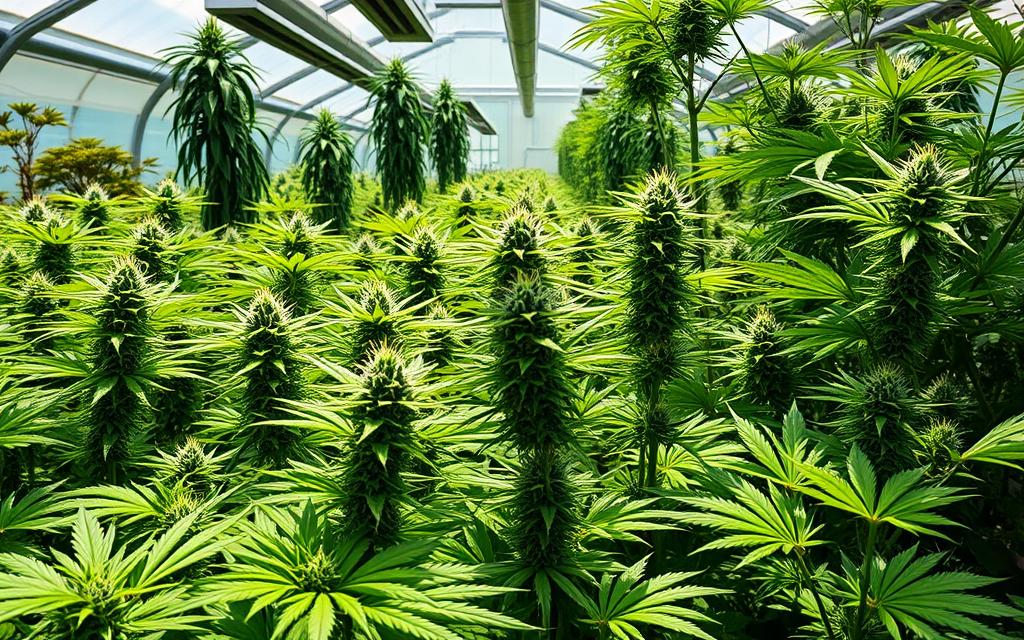
| Growth Stage | Recommended Humidity | Tips for Control |
|---|---|---|
| Vegetative | 63% – 68% | Use fans for airflow and monitor moisture levels. |
| Flowering | 52% – 57% | Implement dehumidifiers and maintain temperature consistency. |
Handling Powdery Mildew and Botrytis
In the world of growing cannabis, it’s vital to deal with powdery mildew and botrytis. These molds can harm your plants’ health and reduce how much you harvest. By using effective mold control strategies, you can keep these issues at bay. We’ll look into how to address powdery mildew and botrytis in your cannabis garden.
Steps for Treating Powdery Mildew
First, check the environment as it may help mildew grow. Keeping the temperature between 20-30°C helps a lot. Here’s what else you can do:
- Try using substances like potassium bicarbonate or baking soda. They change the pH on leaves, stopping mildew.
- Use biofungicides, for example, from Reynoutria sachalinensis. They boost your plants’ own defences.
- In severe cases, you might have to remove sick leaves or the whole plant to save the rest.
Also, make sure your plants have enough space and air. This stops damp spots that mildew loves. Using air filters can catch spores, keeping them away from your garden.
Combating Botrytis Effectively
Botrytis, or bud rot, is tricky because it can appear on different plant parts. To fight it, follow these tips:
- Keep an eye on humidity and keep it under 60%. This helps prevent botrytis.
- Look after your plants with good nutrition and enough light. This makes them stronger against diseases.
- If you find botrytis, cut off the infected parts carefully. Use clean tools to avoid spreading it.
Staying alert and using these mold control strategies means you can handle powdery mildew and botrytis well. This keeps your cannabis grow healthy.
Best Practices for Maintaining Healthy Cannabis Plants
For healthy cannabis plants, a holistic approach is key. This includes proper watering, feeding, pruning, and space management. By doing so, growers boost their crop’s resilience and lower mold risks.
Watering and Nutrition Strategies
Watering is crucial for cannabis health. Too much can cause root rot, and too little can stress the plant. Here are some tips to keep the moisture just right:
- Check soil moisture often to know when to water.
- Make sure pots drain well to avoid water build-up.
- Feed plants with nutrients that match their growth stage.
- Adjust how often you water based on the weather and indoor conditions.
Pruning and Plant Spacing Considerations
Pruning helps plants breathe and soak up light better. It helps them stay healthy and fight off mold. Here’s how to do it right:
- Get rid of any leaves that look dead or yellow. They could carry mold.
- Cut back crowded branches to let air flow.
- Space plants well to avoid crowding and ensure they all get enough light.
Proper spacing lets each plant grow strong without crowding. Keeping plants well-tended reduces mold risk and ensures good harvests. Watching your watering, pruning regularly, and spacing plants correctly are vital for thriving cannabis plants.
| Aspect | Best Practice |
|---|---|
| Watering | Monitor soil moisture and ensure proper drainage |
| Nutrition | Utilise a balanced nutrient mix tailored to growth stages |
| Pruning | Remove dead leaves and thin out crowded branches |
| Plant Spacing | Ensure adequate space for air circulation and light |
Conclusion
Successful cannabis growing needs a deep understanding of challenges like mold, which is a major issue. Knowing about different molds and how to treat them fast is key. If not spotted early, mold can ruin your crop in just a few days.
Being proactive in growing techniques is vital for your plants’ health. Keeping the humidity between 40%-50% and having good air flow helps prevent mold. Also, careful pruning and watering right are important steps to protect your plants.
The secret to healthy cannabis plants is both treating and preventing mold. By following the advice given, growers can produce tougher plants. Taking these steps ensures a big, healthy harvest and less risk of mold. You can keep your crops growing strong by visiting cannabis mold prevention for more tips.

